-
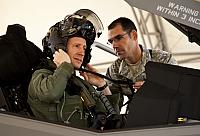
Lt. Col. Eric Smith, the 58th FS director of operations, puts on his helmet as SSgt. Jeremy Houser, 33rd AMXS crew chief, assists prior to the first F-35A Lightning II JSF training sortie at Eglin AFB on March 6th, 2012. [USAF photo by Samuel King Jr.]
-
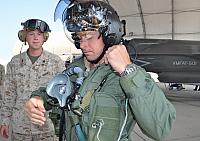
Marine Sgt. Eric Spence, a plane captain with VMFAT-501, and Marine Maj. Joseph Bachmann prepare life support equipment for their first F-35B sortie on May 22nd, 2012. [USAF photo by Maj. Karen Roganov]
-
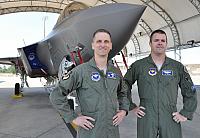
Lt. Col. Randal Efferson (left) and Maj. Jay Spohn stand in front of a F-35 at Eglin AFB on May 11th, 2012. The Florida Air National Guardsmen are the only National Guard pilots currently assigned to the 33rd OG and they’ll soon be taking to the skies to master the F-35 Lightning II Joint Strike Fighter. [USAF photo by MSgt. Thomas Kielbasa]
-
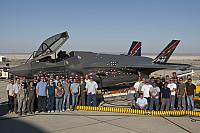
Group shot of the F-35 Combined Test Force team that performed stores static ejection testing on an F-35 at Edwards AFB. [USAF photo by Paul Weatherman & David Henry]
-
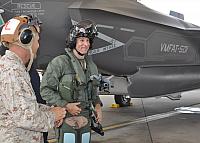
Marine Lt. Col. David Berke, commanding officer for VMFAT-501, taxis in from completing the 100th F-35 Lightning II sortie at the 33rd FW, Eglin AFB on July 11th, 2012. The 33 FW’s 100 flights completed include 74 F-35A sorties and F-35B sorties. [USAF photo by Maj. Karen Roganov]
-
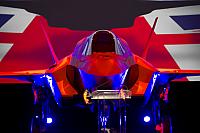
On July 19th, 2012 the United Kingdom took delivery of its first F-35 Lightning II jet during a ceremony at Lockheed Martin in Fort Worth. The jet (BK-1) is an F-35B STOVL model. [Lockheed Martin photo]
-
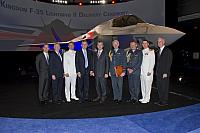
On July 19th, 2012 the United Kingdom took delivery of its first F-35 Lightning II jet during a ceremony at Lockheed Martin in Fort Worth. The jet (BK-1) is an F-35B STOVL model. Pictured (left to right): Robert Stevens, Chairman and Chief Executive Officer of Lockheed Martin; Frank Kendall, U.S. Under Secretary of Defense for Acquisition, Technology and Logistics; Sir George Zambellas, UK Fleet Commander and Deputy Chief of Naval Staff; Rt Hon Philip Hammond MP, UK Secretary of State for Defence; Larry Lawson, Executive Vice President, Lockheed Martin Corporation and President, Lockheed Martin Aeronautics company; Air Chief Marshal Sir Stephen Dalton, UK Chief of the Air Staff; Air Marshal Sir Kevin Leeson; Air Member for Materiel and Chief of Materiel (Air); Vice Admiral David Venlet, F-35 Lightning II Program Executive Officer; Tom Burbage, Executive Vice President and General Manager, F-35 JSF Program Integration. [Lockheed Martin photo]
-
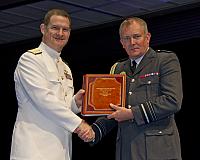
Vice Admiral David Venlet, F-35 Lightning II Program Executive Officer, handing the first UK F-35’s log book to Air Member for Materiel and Chief of Materiel (Air) Air Marshal Sir Kevin Leeson on July 19th, 2012. [Lockheed Martin photo]
-
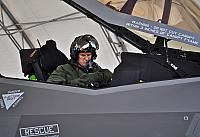
Lt. Col. Lee Kloos, 58th FS commander, prepares to exit an F-35A Lightning II joint strike fighter, after a successful sortie on May 31st, 2012. Kloos is the first non-developmental test pilot to fly the JSF and now trains other 33rd FW initial cadre pilots to fly the F-35. [USAF photo by Maj. Karen Roganov]
-
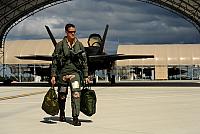
Maj. Adam Levine from the VMFAT-501, Eglin AFB, walks back to his squadron after conducting a local training mission over the Emerald Coast on September 18th, 2012. [USAF photo by MSgt. Jeremy T. Lock]
-
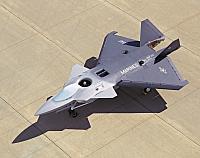
The aircraft Lockheed proposed for the Common Affordable Lightweight Fighter was called Configuration 100. The delta-canard design had twin vertical tails and a pronounced forebody chine. Trade studies were conducted to refine the design in late 1993. Configuration 140 emerged as a baseline used to build a 92 percent scale powered model. The requirements for testing the model in the NASA Ames 80- by 120-foot wind tunnel called for a safety factor of five times the normal design loads. To meet these requirements, the model was fabricated from sheets of 1/4-inch steel plate. The result, which weighed almost 50,000 pounds, incorporated an F100 engine and a lift fan built from the first stage of an F119 engine. The model was used to test the interaction of the airflow from lift fan and the aft nozzle. The data gathered from this these tests helped Lockheed win the Concept Development phase of the X-35 program. [Lockheed photo]
-
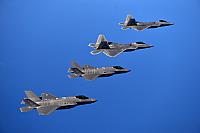
F-22 Raptors from the 94th FS, Joint Base Langley-Eustis, Virginia, and F-35A Lightning IIs from the 58th FS, Eglin AFB, fly in formation after completing an integration training mission over the Eglin Training Range, Florida on November 5, 2014. [USAF by photo MSgt. Shane A. Cuomo]
-
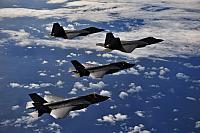
F-22 Raptors from the 94th FS, Joint Base Langley-Eustis, Virginia, and F-35A Lightning IIs from the 58th FS, Eglin AFB, fly in formation after completing an integration training mission over the Eglin Training Range, Florida on November 5, 2014. [USAF by photo MSgt. Shane A. Cuomo]
-
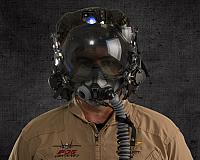
F-35’s Helmet Mounted Display Systems provide pilots with unprecedented situational awareness. All the information pilots need to complete their missions – airspeed, heading, altitude, targeting information and warnings – is projected on the helmet’s visor, rather than on a traditional Heads-up Display. [Lockheed photo]
-
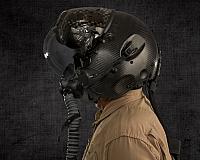
F-35’s Helmet Mounted Display Systems provide pilots with unprecedented situational awareness. All the information pilots need to complete their missions – airspeed, heading, altitude, targeting information and warnings – is projected on the helmet’s visor, rather than on a traditional Heads-up Display. [Lockheed photo]
 Lt. Col. Eric Smith, the 58th FS director of operations, puts on his helmet as SSgt. Jeremy Houser, 33rd AMXS crew chief, assists prior to the first F-35A Lightning II JSF training sortie at Eglin AFB on March 6th, 2012. [USAF photo by Samuel King Jr.]
Lt. Col. Eric Smith, the 58th FS director of operations, puts on his helmet as SSgt. Jeremy Houser, 33rd AMXS crew chief, assists prior to the first F-35A Lightning II JSF training sortie at Eglin AFB on March 6th, 2012. [USAF photo by Samuel King Jr.] Marine Sgt. Eric Spence, a plane captain with VMFAT-501, and Marine Maj. Joseph Bachmann prepare life support equipment for their first F-35B sortie on May 22nd, 2012. [USAF photo by Maj. Karen Roganov]
Marine Sgt. Eric Spence, a plane captain with VMFAT-501, and Marine Maj. Joseph Bachmann prepare life support equipment for their first F-35B sortie on May 22nd, 2012. [USAF photo by Maj. Karen Roganov] Lt. Col. Randal Efferson (left) and Maj. Jay Spohn stand in front of a F-35 at Eglin AFB on May 11th, 2012. The Florida Air National Guardsmen are the only National Guard pilots currently assigned to the 33rd OG and they’ll soon be taking to the skies to master the F-35 Lightning II Joint Strike Fighter. [USAF photo by MSgt. Thomas Kielbasa]
Lt. Col. Randal Efferson (left) and Maj. Jay Spohn stand in front of a F-35 at Eglin AFB on May 11th, 2012. The Florida Air National Guardsmen are the only National Guard pilots currently assigned to the 33rd OG and they’ll soon be taking to the skies to master the F-35 Lightning II Joint Strike Fighter. [USAF photo by MSgt. Thomas Kielbasa] Group shot of the F-35 Combined Test Force team that performed stores static ejection testing on an F-35 at Edwards AFB. [USAF photo by Paul Weatherman & David Henry]
Group shot of the F-35 Combined Test Force team that performed stores static ejection testing on an F-35 at Edwards AFB. [USAF photo by Paul Weatherman & David Henry] Marine Lt. Col. David Berke, commanding officer for VMFAT-501, taxis in from completing the 100th F-35 Lightning II sortie at the 33rd FW, Eglin AFB on July 11th, 2012. The 33 FW’s 100 flights completed include 74 F-35A sorties and F-35B sorties. [USAF photo by Maj. Karen Roganov]
Marine Lt. Col. David Berke, commanding officer for VMFAT-501, taxis in from completing the 100th F-35 Lightning II sortie at the 33rd FW, Eglin AFB on July 11th, 2012. The 33 FW’s 100 flights completed include 74 F-35A sorties and F-35B sorties. [USAF photo by Maj. Karen Roganov] On July 19th, 2012 the United Kingdom took delivery of its first F-35 Lightning II jet during a ceremony at Lockheed Martin in Fort Worth. The jet (BK-1) is an F-35B STOVL model. [Lockheed Martin photo]
On July 19th, 2012 the United Kingdom took delivery of its first F-35 Lightning II jet during a ceremony at Lockheed Martin in Fort Worth. The jet (BK-1) is an F-35B STOVL model. [Lockheed Martin photo] On July 19th, 2012 the United Kingdom took delivery of its first F-35 Lightning II jet during a ceremony at Lockheed Martin in Fort Worth. The jet (BK-1) is an F-35B STOVL model. Pictured (left to right): Robert Stevens, Chairman and Chief Executive Officer of Lockheed Martin; Frank Kendall, U.S. Under Secretary of Defense for Acquisition, Technology and Logistics; Sir George Zambellas, UK Fleet Commander and Deputy Chief of Naval Staff; Rt Hon Philip Hammond MP, UK Secretary of State for Defence; Larry Lawson, Executive Vice President, Lockheed Martin Corporation and President, Lockheed Martin Aeronautics company; Air Chief Marshal Sir Stephen Dalton, UK Chief of the Air Staff; Air Marshal Sir Kevin Leeson; Air Member for Materiel and Chief of Materiel (Air); Vice Admiral David Venlet, F-35 Lightning II Program Executive Officer; Tom Burbage, Executive Vice President and General Manager, F-35 JSF Program Integration. [Lockheed Martin photo]
On July 19th, 2012 the United Kingdom took delivery of its first F-35 Lightning II jet during a ceremony at Lockheed Martin in Fort Worth. The jet (BK-1) is an F-35B STOVL model. Pictured (left to right): Robert Stevens, Chairman and Chief Executive Officer of Lockheed Martin; Frank Kendall, U.S. Under Secretary of Defense for Acquisition, Technology and Logistics; Sir George Zambellas, UK Fleet Commander and Deputy Chief of Naval Staff; Rt Hon Philip Hammond MP, UK Secretary of State for Defence; Larry Lawson, Executive Vice President, Lockheed Martin Corporation and President, Lockheed Martin Aeronautics company; Air Chief Marshal Sir Stephen Dalton, UK Chief of the Air Staff; Air Marshal Sir Kevin Leeson; Air Member for Materiel and Chief of Materiel (Air); Vice Admiral David Venlet, F-35 Lightning II Program Executive Officer; Tom Burbage, Executive Vice President and General Manager, F-35 JSF Program Integration. [Lockheed Martin photo] Vice Admiral David Venlet, F-35 Lightning II Program Executive Officer, handing the first UK F-35’s log book to Air Member for Materiel and Chief of Materiel (Air) Air Marshal Sir Kevin Leeson on July 19th, 2012. [Lockheed Martin photo]
Vice Admiral David Venlet, F-35 Lightning II Program Executive Officer, handing the first UK F-35’s log book to Air Member for Materiel and Chief of Materiel (Air) Air Marshal Sir Kevin Leeson on July 19th, 2012. [Lockheed Martin photo] Lt. Col. Lee Kloos, 58th FS commander, prepares to exit an F-35A Lightning II joint strike fighter, after a successful sortie on May 31st, 2012. Kloos is the first non-developmental test pilot to fly the JSF and now trains other 33rd FW initial cadre pilots to fly the F-35. [USAF photo by Maj. Karen Roganov]
Lt. Col. Lee Kloos, 58th FS commander, prepares to exit an F-35A Lightning II joint strike fighter, after a successful sortie on May 31st, 2012. Kloos is the first non-developmental test pilot to fly the JSF and now trains other 33rd FW initial cadre pilots to fly the F-35. [USAF photo by Maj. Karen Roganov] Maj. Adam Levine from the VMFAT-501, Eglin AFB, walks back to his squadron after conducting a local training mission over the Emerald Coast on September 18th, 2012. [USAF photo by MSgt. Jeremy T. Lock]
Maj. Adam Levine from the VMFAT-501, Eglin AFB, walks back to his squadron after conducting a local training mission over the Emerald Coast on September 18th, 2012. [USAF photo by MSgt. Jeremy T. Lock] The aircraft Lockheed proposed for the Common Affordable Lightweight Fighter was called Configuration 100. The delta-canard design had twin vertical tails and a pronounced forebody chine. Trade studies were conducted to refine the design in late 1993. Configuration 140 emerged as a baseline used to build a 92 percent scale powered model. The requirements for testing the model in the NASA Ames 80- by 120-foot wind tunnel called for a safety factor of five times the normal design loads. To meet these requirements, the model was fabricated from sheets of 1/4-inch steel plate. The result, which weighed almost 50,000 pounds, incorporated an F100 engine and a lift fan built from the first stage of an F119 engine. The model was used to test the interaction of the airflow from lift fan and the aft nozzle. The data gathered from this these tests helped Lockheed win the Concept Development phase of the X-35 program. [Lockheed photo]
The aircraft Lockheed proposed for the Common Affordable Lightweight Fighter was called Configuration 100. The delta-canard design had twin vertical tails and a pronounced forebody chine. Trade studies were conducted to refine the design in late 1993. Configuration 140 emerged as a baseline used to build a 92 percent scale powered model. The requirements for testing the model in the NASA Ames 80- by 120-foot wind tunnel called for a safety factor of five times the normal design loads. To meet these requirements, the model was fabricated from sheets of 1/4-inch steel plate. The result, which weighed almost 50,000 pounds, incorporated an F100 engine and a lift fan built from the first stage of an F119 engine. The model was used to test the interaction of the airflow from lift fan and the aft nozzle. The data gathered from this these tests helped Lockheed win the Concept Development phase of the X-35 program. [Lockheed photo] F-22 Raptors from the 94th FS, Joint Base Langley-Eustis, Virginia, and F-35A Lightning IIs from the 58th FS, Eglin AFB, fly in formation after completing an integration training mission over the Eglin Training Range, Florida on November 5, 2014. [USAF by photo MSgt. Shane A. Cuomo]
F-22 Raptors from the 94th FS, Joint Base Langley-Eustis, Virginia, and F-35A Lightning IIs from the 58th FS, Eglin AFB, fly in formation after completing an integration training mission over the Eglin Training Range, Florida on November 5, 2014. [USAF by photo MSgt. Shane A. Cuomo] F-35’s Helmet Mounted Display Systems provide pilots with unprecedented situational awareness. All the information pilots need to complete their missions – airspeed, heading, altitude, targeting information and warnings – is projected on the helmet’s visor, rather than on a traditional Heads-up Display. [Lockheed photo]
F-35’s Helmet Mounted Display Systems provide pilots with unprecedented situational awareness. All the information pilots need to complete their missions – airspeed, heading, altitude, targeting information and warnings – is projected on the helmet’s visor, rather than on a traditional Heads-up Display. [Lockheed photo] F-35’s Helmet Mounted Display Systems provide pilots with unprecedented situational awareness. All the information pilots need to complete their missions – airspeed, heading, altitude, targeting information and warnings – is projected on the helmet’s visor, rather than on a traditional Heads-up Display. [Lockheed photo]
F-35’s Helmet Mounted Display Systems provide pilots with unprecedented situational awareness. All the information pilots need to complete their missions – airspeed, heading, altitude, targeting information and warnings – is projected on the helmet’s visor, rather than on a traditional Heads-up Display. [Lockheed photo]